Vol 4 No. 17 TROPIC LIGHTNING NEWS April 28, 1969
Index
| Unit Page | Unit Page | Unit Page | Unit Page |
| 1/5 3 | 2/27 1 | 25th Avn 3 | 4/23 8 |
| 1/5 Photo 7 | 2/27 1 | 2/77 Arty 6 | 4/23 8 |
| 1/5 8 | 2/27 Photo 3 | 3/13 3 | 4/23 Photo 8 |
| 1/5 Photo 8 | 2/27 Photo 6 | 3/13 6 | 4/9 3 |
| 1/8 Arty 1 | 2/32 Arty 6 | 3/22 Photos 4/5 | 4/9 Photo 3 |
| 2/12 3 | 2/34 Armor 8 | 4/23 6 | 4/9 7 |
| 2/22 6 | 25th Avn 1 |
Wolfhounds, Arty,
Gunships Kill 198
DIAMONDS ARE FOREVER
PATROL BASE DIAMOND - Dawn's first light shows sweat, dirt
and exhaustion engraved on their faces. Some try to sleep, others stare blankly into the
distance. A few talk. A deep weariness prevails over the sweet smell of gunpowder.
Four hours ago an estimated two battalions of North Vietnamese Regulars swept
across the Cambodian border and hurled themselves at the Fire Brigade's 2nd Battalion 27th
Infantry in this tiny patrol base on a dry open plain. The Wolfhounds fought for their
lives and now it shows.
The men of Alpha and Delta Companies killed 198 NVA regulars in a battle they
will talk about for years and remember for a lifetime. Twenty five hours ago they
dismantled Diamond II and moved it, gun, beam and sandbag to this new position, a job
which would normally require three days.
Working swiftly against time the entire battalion carved a defensive position
which had to hold. The enemy had attacked on the first night in the previous position and
would likely attack again here.
At midnight Patrol Base Diamond III was ready. Guards were posted and the
infantrymen tried to rest.
As the guard changed at 0300 movement was detected 800 meters to the
southwest of the perimeter. The command post was notified and the first of nearly 2000
rounds of artillery was called in. Gunships from B Company, 25th Aviation Battalion were
called in and the battle began .
The mortars started at 0315. It was the most intense mortar attack that I
have ever experienced, twice as bad as the attacks on Diamond I and Diamond II," said
1st Lieutenant James J. Sullivan, Chaton, N.J.
Specialist Five Eino Honkala, Vancouver, Wash., reported: "The shells
really rained in. It sounded like automatic mortar."
Few were injured as an estimated 500 mortar shells exploded against the
overhead cover constructed that afternoon. A lull fell on the battlefield. The NVA
had lifted the mortar attack to allow their assault troops to move closer.
Earlier that evening, three listening posts had been established, one to the
west, one to the north, and one to the south. Wolfhounds at the western LP took advantage
of the lull to break for the patrol base.
They made it. The post to the east suffered several casualties, while the
post to the north held, kept low, and had no injuries.
Experienced troopers knew that the time had come to get out of their bunkers
and fight from the prepared positions. "Getting out of that bunker," said
Specialist Four Paul Gaither of Elkins, No. Carolina, "was one of the hardest things
I have ever done. But I kept remembering what could happen if I remained."
The NVA regulars proved themselves creatures of habit as, true to form, they
launched the second phase of the attack with a hail of RPG's and small arms fire. The NVA
Battalion had moved forward under the mortar fire and were launching their deadly rockets
from within 30 meters of the perimeter.
Major Calvin Swenson, Diamond's Commander, from Wilson, No. Carolina,
estimated that 400 RPG's struck around the base. Time after time positions took direct
hits, but none were knocked out.
The men, fighting outside their bunkers, kept the enemy from getting close
enough to accurately fire their weapons. Each bunker had an M-60 machinegun, and many had
90mm recoilless rifles. The Wolfhounds knew how to use them.
As the RPG's rained in, sapper squads closed on the perimeter's defensive
wire armed with bangalore torpedoes and AK-47's in a desperate attempt to breech the line.
Specialist Four William Baumgardner of Huntington, Pa., recalled: "They blew the wire
to the front and right of my position. So we put a lot of fire in that direction. We were
ready for them, and they never got inside."
Flare ships and night lighting aircraft circled above illuminating the scene
as dust and debris rose from rounds impacting on both sides.
The beleaguered infantrymen were not alone here, last night. All the
firepower the Tropic Lightning Division could call on was here in support. Artillery,
gunships and air strikes broke the back of the advancing enemy as automatic weapons cut
him down in front.
As the fight continued, eight gunships circled overhead constantly spitting
their fire onto the plain below. The Air Force came in with jet air strikes on the staging
area used by the enemy.
The two 105mm howitzers from C Battery, 1st Battalion Eighth Artillery fired
an incredible 300 rounds and, during the height of the battle, lowered their tubes and
fired point blank into the charging NVA.
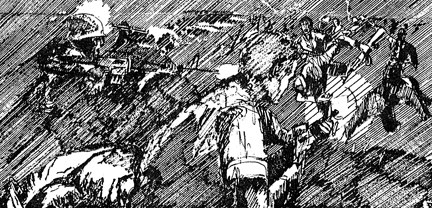 The heavy fighting continued until the rising moon warned the NVA
of the coming dawn. They broke contact and, leaving a few behind to continue the fire,
retreated to their sanctuary across the border. The fighting subsided shortly before 6:30
a.m.
The heavy fighting continued until the rising moon warned the NVA
of the coming dawn. They broke contact and, leaving a few behind to continue the fire,
retreated to their sanctuary across the border. The fighting subsided shortly before 6:30
a.m.
The gunships have returned to base, the guns are quiet. Patrol Base Diamond
III is intact. The men have a right to be exhausted, they have fought hard. Victory does
not come easily, or cheaply. Thirteen Americans lost their lives in the battle.
Drawing by 2d Battalion, 27th Infantry artist Specialist 4 Dennis Tupper
| Soldiering is a profession, and you must be a professional. Know the tools of your profession - weapons and explosives and treat them with respect. Share your knowledge with those you work with, and don't be afraid to ask questions of them. Remember that the next mistake you make could be your last. |
NVA Fall at Diamond II, Too
On April 5th and 6th in the second round of battle for the
Diamond Patrol bases along the Angel's Wing, two companies of the 2d Battalion, 27th
Infantry Wolfhounds wrecked two battalions of the North Vietnamese Army, killing 117.
Soldiering is a profession, and you must be a professional. Know the tools of
your profession - weapons and explosives and treat them with respect. Share your knowledge
with those you work with, and don't be afraid to ask questions of them. Remember that the
next mistake you make could be your last.
Shortly after 1 a.m. April 5, troops detected a small group of people 800
meters from the perimeter. Specialist 5 Harold T. Gillespie of Compton, Calif.,
said, "They were moving around in one location, and were apparently setting up a
mortar position. Other detected groups moving around the base drew artillery fire."
Then, at 1:30 a.m., the enemy began mortaring a listening post 200 meters
west of the base's wire. This fire was quickly shifted into the perimeter.
"We got up to look around," said Specialist 4 Kenneth Brink of
Laingsburg, Mich., "and the first thing I saw was a whole bunch of enemy soldiers
running right at us. It reminded me of an end run going through my position in a football
game."
"The NVA had apparently 'been planning on using the cover in the
listening post's site to place fire on the perimeter," said Specialist 4 Algher
Griffin of Rochester New York. "They were carrying a heavy weapon of some sort. We
changed their plans when we opened up on them."
From their vantage point, the Wolfhounds saw the enemy thunder at the
perimeter in vain. None reached the wire, deadly rounds fired from leveled
howitzers, devastating airstrikes of pinpoint accuracy and fierce small arms fire saw to
that.
Five a.m. found the enemy blasted by Wolfhounds and retreating from the
coming dawn. "The battle was actually over almost before it get started,"
1LT Robert Nebiker of Maywood, N.J., said. The enemy was starting to carry away his dead
within ten minutes after the attack started."
Another lieutenant said the biggest problem was the dust raised by the enemy
mortars. He reported the Wolfhounds could hardly see the enemy advancing through the dust.
With the coming of full light the Wolfhounds policed up the debris of their
victory. Found were 81 Chi-Com grenades, 9 bangalore torpedoes, 34 RPG rounds, 14 RPG
launchers and 21 AK assault rifles. The enemy, normally scrupulous about taking his
dead from the battlefield, had left behind 81 bodies in his flight.
On April 6th an even more abortive attempt was launched on Patrol base
Diamond II, as artillery and gunships killed 36 NVA. They got no closer to the wire than
l,200 meters.
Page 2 TROPIC LIGHTNING NEWS April 28, 1969
MPC Use Protects Allies, Stifles Reds' Black Market
SAIGON—The control and proper use of money are of great
importance in Vietnam. Illegal currency transactions - black marketing in money - harm our
own war effort and the economy of Vietnam. Sound money is a basic requirement for war just
as it is for a stable economy. This is why the Military Assistance Command, Vietnam, in
co-operation with the government of the Republic of Vietnam, has issued strict regulations
on the handling and circulation of money in the command.
Failure to comply with these regulations can result in severe consequences
for the individual and for the nation. The following questions and answers are intended to
explain what the regulations are and how to follow them.
Q. Why do we use MPC?
A. MPC, Military Payment Certificates, are issued as a substitute
for "green" U.S. dollars. MPC are issued in areas such as Vietnam, where the
free circulation of dollars would result in their being siphoned off for purposes which
would harm the U.S. or the host country.
The U.S. dollar is one of three international currencies. It will buy goods
in any market in the world. Many nations attempt to get U.S. dollars by legal or illegal
means in order to buy on the world market. This is particularly true of communist nations
which do not have normal trade relations with the free world. It is undoubtedly true of
North Vietnam and Red China.
There is another side to this problem. Vietnam, like many nations needs to
keep its money at home to provide capital for growth. People in Vietnam who convert
piasters to dollars have a currency which they can get out of the country, leaving the
Vietnamese economy poorer.
Q. Who is authorized to have MPC?
A. MPC are for use only in U.S. facilities (exchanges, clubs, etc.)
and only authorized patrons of those facilities may possess MPC. All MACV personnel, upon
entry into Vietnam, convert all U.S. dollars or dollar instruments into MPC or piasters,
or both.
Q. Why do people who aren't authorized MPC try to get them?
A. Two reasons. One is they want to gain illegal possession of the
goods and services which can be purchased with MPC. For example, they may try to bribe or
"con" military personnel into buying items for them at the PX. Two, they want to
convert the MPC into green dollars, money they can take out of Vietnam. Again, these
people often try to do this through military personnel.
Q. Why is the legal rate of exchange lower than that of the black
market?
A. People who don't have faith in their government's currency prefer
to have a "hard" currency which holds its value. Also, other people want U.S.
dollars for even less legal uses, and are willing to pay a high price for them.
Q. Where can I convert MPC to piasters?
A. Only at authorized conversion points operated by the U.S.
agencies, in many billets, compounds, etc.
Q. Can I convert piasters to MPC? To dollars?
A. MPC, no; dollars, yes - in some cases. If you leave Vietnam on
emergency leave or for medical evacuation you can convert piasters at port of exit up to
the amount of your most recent monthly net pay - the actual pay you draw here. Leaving on
a permanent change of station, you can convert up to $40 worth.
Q, How about going en R&R or TDY?
A. No. Leaving the command on R&R or TDY you can convert MPC to
dollars but not piasters to dollars. This is usually done after you check in for your
flight, at the port of exit.
Q. If I wanted to take plasters out of Vietnam, would it be OK?
A. Only up to 500. Written permission of the RVN government is
required for you to take out or bring in more than 500 piasters.
Q. If a Vietnamese asks me to exchange his MPC into plasters, can I
do it?
A. Only if you want to engage in illegal black market operations.
MACV directive 37-6 says, "U.S. authorized personnel will not deal in any manner with
persons not authorized to possess MPC. All transaction in RVN between U.S. authorized
personnel and unauthorized personnel will be consummated in piasters."
Q. If I accidentally get into a position of having no plasters with
me, can I pay, say, a taxi driver in MPC?
A. Definitely not. Your giving MPC to him is worse than taking it
from him. It might not be your fault that he had MPC before, but it sure is if you give it
to him.
Q. What about when a command changes its MPC, exchanging the size or
design, calllng in the old and issuing new? What is that for and how do they do it?
A. It’s done to spoil as many crooked operations as possible,
to catch illegal operators who have the old scrip in their possession. The old is quickly
called in, on short notice, and the new goes to the troops in its place dollar for dollar.
Q. What happens to dollars that get on the black market?
A. Black market dollars can end up as payments for communist weapons
and supplies. U.S. dollars are gathered here and elsewhere, smuggled to places like Honk
Kong and funneled into Red China or other communist countries. The communists have major
accounts with many international banks, contracts with many munitions suppliers throughout
the world. In effect the dollars you place into the black market pool in Vietnam could pay
for the gun and bullets that kill you.
Q. If I'm caught in some improper money deal, what happens?
A. First, when you say "improper," you should say
"illegal." Under the Uniform Code of Military Justice, you could, if convicted
of illegal currency activities at a court martial, be sentenced to 18 months confinement
at hard labor, total forfeiture of pay, and a dishonorable discharge. One man was
sentenced to dismissal from the Service, two years at hard labor, and payment of a $3,000
fine. MACV and all subordinate commands have been cracking down on black market and
illegal currency operations. Such dealings not only put the military in a very bad light,
but also do considerable damage to the economy of the host nation and to the security of
U.S. and other Free World Forces.
Decorated
| BRONZE STAR MEDAL (HEROISM) | |
| LTC William J. Cummings, HHC, 2d
Bn, 14th Inf MAJ George B. Sweet, 25th MI Det CPT James F. Harvey, C Btry, 7th Bn, 11th Arty 1LT Lauren E. Johnson, 2d Bde Mobile Training Team 1LT James W. Conway, A Btry, 7th Bn, 11thArty 1LT Gary W. Carlson, B Trp, 3d Sqdn, 4th Cav 1LT Michael D. Jackson, C Trp, 3d Sqdn, 4th Cav 1LT Dennis Gnas, Co D, 2d Bn, 12th Inf 1LT Andrew D. Malloy, Co B, 1st Bn, 5th Inf 1LT Jerry D. Pruitt, HHC, 2d Bn, 12th Inf 1LT Andrew C. Allred, Co A, 1st Bn, 5th Inf 1LT Eddie G. Rigsby, Co A, 2d Bn, 14th Inf 1LT Michael D. Jackson, C Trp, 3d Sqdn, 4th Cav 1LT Michael D. May, Co D, 1st Bn, 27th Inf 1LT John R. Moore, A Trp, 3d Sqdn, 4th Cav 2LT Jerome P. Klar, A Trp, 3d Sqdn, 4th Cav MSG Phillip F. Dice, HHC, 1st Bn, 5th Inf 1SG Harvey L. Harper, Co B, 1st Bn, 5th Inf 1SG Ernest C. Randolph, Co A, 1st Bn, 27th Inf 1SG Douglas C. Raab, 25th MI Det SSG Jerry Smart, HHC, 4th Bn, 23d Inf SSG James Timbrook, C Btry, 2d Bn, 77th Arty SGT Bennie D. Begay, HHC, 3d Bn, 22d Inf SP5 Roland D. Kimbrough, HHB, 2d Bn, 77th Arty SP4 Robert K. Williams, HHC, 3d Bn, 22d Inf SP4 Ronald L. Stetson, HHC, 3d Bn, 22d Inf SP4 Charles W. Spalding, HHC, 3d Bn, 22d Inf SP4 Dale L. Robinson, HHC, 3d Bn, 22d Inf SP4 Patrick G. Camacho, HHC, 3d Bn, 22d Inf SP4 James G. Balk, HHB, 2d Bn, 77th Arty SP4 Anthony J. Nagy, HHC, 3d Bn, 22d Inf |
SP4 Jarnes T. Archambult, HHC, 3d
Bn, 22d Inf SP4 Raymond B. Tsosie, HHB, 2d Bn, 77th Arty SP4 Larry D. Lazoen, HHB, 2d Bn, 77th Arty SP4 Donald R. Anderson, HHB, 2d Bn, 77th Arty SP4 Jay W. Taylor, HHB, 2d Bn, 77th Arty SP4 Edward MacDonald, HHB, 2d Bn, 77th Arty SP4 John C. Clancy, Co D, 2d Bn, 12th Inf SP4 Robert J. Harrold, 1st Bn, 5th Inf SP4 Cleveland Johnson, Co D, 2d Bn, 12th Inf SP4 Joseph B. Baltuska, Jr., Co A, 1st Bn, 5th Inf SP4 Alex H. Johnson, Co A, 1st Bn, 5th Inf SP4 Roy A. Montenero, Co A, 1st Bn, 5th Inf SP4 Lewis A.Pappalardo, Co A, 1st Bn, 5th InI SP4: John S. Murphy, Co A, 1st Bn, 5th Inf SP4 Michael A. Monson, Co A, 1st Bn, 5th Inf SP4 Lonnie W. Cruse, Co A, 1st Bn, 5th Inf SP4 Mike Miller, Co A, 2d Bn, 14th lnf SP4 Albert J. Herbert, A Trp, 3d Sqdn, 4th Cav SP4 Ronald K. Moore, A Trp, 3d Sqdn, 4th Cav SP4 Robert J. Calhoun, A Trp, 3d Sqdn, 4th Cav SP4 Charles C. Patterson, A Trp, 3d Sqdn, 4th Cav SP4 Richard C. Millis, A Trp, 3d Sqdn, 4th Cav SP4 Gary W. Barlow, A Trp, 3d Sqdn, 4th Cav PFC Steven M. Britton, Co A, 1st Bn, 5th Inf PFC James W. Ash, Co A, 1st Bn, 5th Inf PFC Buddy Brockington, Co A, 1st Bn, 5th Inf PFC Richard D. Kirk, HHC, 4th Bn, 23d Inf PFC Robert W. Raymond, HHB, 2d Bn, 77th Arty PFC Wilna G. Dennis, Co A, 1st Bn, 5th Inf PFC Alex Washington, Co D, 2d Bn, 12th Inf |
Tropic Lightning Tots
The Commanding General Welcomes
The Following Tropic Lightning Tots
To The 25th Infantry Division – As
Reported By The American Red Cross.
Born To:
| April 4 SP4 James C. Baisch, 25th Admin Co, a son April 7 SSG Paul L. Smith, 25th Admin Co, a son April 9 SP5 Terry G. Trout, Co E 725 Maint Bn, twin daughters April 10 SP4 James R. Miller, HHC 1/5 Inf, a son |
April 11 SP4 Joe Ray, HHC 2/14 Inf, a daughter April 12 PVT Jose Quinones, Co C 2/27 Inf, a daughter SP4 Walter Herrick, HHC 2d Bde, a daughter April 15 2LT Walter N. Weiler, HHC Band DISCOM, a daughter |
The TROPIC LIGHTNING NEWS is an authorized publication of the 25th Infantry Division. It is published weekly for all division units in the Republic of Vietnam by the Information Office, 25th Infantry Division, APO San Francisco 96225. Army News Features, Army Photo Features, Armed Forces Press Service and Armed Forces News Bureau material are used. Views and opinions expressed are not necessarily those of the Department of the Army. Printed in Tokyo, Japan, by Pacific Stars and Stripes.
MG Ellis W. Williamson . . . . Commanding General
MAJ John C. Fairbank . . . . . Information Officer
1LT John C. Burns . . . . . . . . Officer-in-Charge
SP4 Robert Imler . . . . . . . . . . Editor
SP5 Charles Withrow . . . . . . Assistant Editor
SP4 Jim Brayer . . . . . . . . . . . . Production Supervisor
Page 3 TROPIC LIGHTNING NEWS April 28, 1969
GIs Find ARVNs Generous,
Capable
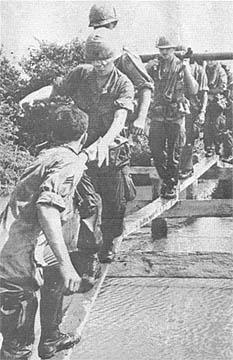 TAY NINH – "It was really an interesting
experience, a chance to see how the Vietnamese live, a chance to learn a lot about how
they're different from us, and how we're all the same."
TAY NINH – "It was really an interesting
experience, a chance to see how the Vietnamese live, a chance to learn a lot about how
they're different from us, and how we're all the same."
That was the reaction of Private First Class Gerald W. Windhorst, Louisville,
Ky., to spending a week living and working with a South Vietnamese Army unit in Tien Thom
village, 16 miles southeast of Tay Ninh.
Windhorst was part of a squad from the 4th Battalion, 9th Infantry Manchus' B
Company who made the mile-and-a-half trip from Fire Support Base Sedgwick for the week's
stay at the village.
The squad, led by Sergeant Pete Bauer, Bismarck, N.D., worked joint ambush
patrols with the ARVN forces at night and during the day tried out Vietnam's food, customs
and language.
"We learned right away that those ARVNs really know what they're doing
militarily," Bauer said at the end of the week. Private First Class Rudy L.
Hopkins, Box 183, Adairsville Ga., "did the best at picking up the Vietnamese
language," according to Windhorst.
Windhorst says he was struck by the Vietnamese's generosity. Windhorst added
that he'd like to spend some more time in the village. "It was really worth our
while," he said. "I think there was a big increase in our understanding of each
other after that week."
ALL ASHORE THAT'S GOING ASHORE - (above, right)
Manchus of the 4th Battalion, 9th Infantry, inch their way across a thin plank that
affords the only way of crossing a deep stream. All of the troops made it across and kept
their powder dry, with the first and last men across providing security. (PHOTO BY SP4
RALPH NOVAK)
Warriors Turn Tables on
Enemy Mortar Squad
By SP4 P. A. BROWN
CU CHI - Somewhere there is an enemy mortar squad that must still
be wondering what happened to its mortars and rockets.
A squad of 2nd Battalion, 12th Infantry soldiers, after discovering an enemy
rocket launching site, turned the launch pads so that all the rockets would land off
target.
The 2nd Brigade White Warriors were on a sweep around their fire
support base when the point man spotted the first position. "When I first spotted it,
I was sure it was a mortar position," said Specialist 4 Jack Short of New Port
Richey, Fla. "It was complete with aiming stakes," added Specialist 4 James
Howard of Daytona Beach, Fla. "We continued searching the area and found a rocket
launching position."
The "Mod Squad," as it is called, decided to play the trick on
Charlie. "We reported the positions to our commanding officer," said squad
leader Sergeant Darril Walden of Girrard, Ill., "then instead of destroying the
positions only to have Charlie rebuild then again, we moved all of the aiming stakes
without disturbing the area."
That night, sure enough, Charlie began to fire but none of the rounds landed
near the Tropic Lightning positions. In fact the rounds fell outside the perimeter into
uninhabited area surrounding the base. The first rockets fired went over the perimeter.
"We couldn't move the rocket firing positions so we elevated the
stakes," said Specialist 4 Mike Aguilar of Lockhart, Texas. "This caused the
rounds to pass over the base." The enemy evidently realized something was wrong and
began adjusting. When the rounds began falling closer, eight-inch guns from D Battery, 3d
Battalion, 13th Artillery opened up on the enemy positions and silenced them.
Choppers Add Firepower,
Light to Diamond Defense
By 1LT BERNARDINO VARGAS
CU CHI - Seconds after the first enemy fire slammed into Patrol Base
Diamond III, three-minute alert gunship crews of the 25th Aviation Battalion's Bravo
Company were sprinting for their aircraft. Responding to the base's 3 a.m. call, the
Diamondheads guided their Cobras through gathering overcast toward the action and were
quickly directed in to the assistance of the embattled infantry.
They found the scene of the action covered with low clouds and were forced to
work down in the cauldron of fire that Patrol Base Diamond III had become. Swooping in by
the light of flares flickering eerily on the low clouds, the Diamondheads scourged the
attacking NVA with mini-gun and rocket fire. Under direction of the ground commanders, the
gunships engaged the enemy right up to the edge of the perimeter.
With the pressure on the infantry eased, the Diamondheads pounced on .51
caliber machine gun positions that had been trying to break up the helicopter attacks.
Eight were suppressed with rocket fire. Diamondhead fire teams alternated on station over
Diamond III all through the attack. By 5:15 a.m. all the NVA who weren't on the ground
were going some place else, and the firing died down. The gunships continued to orbit
protectively over the base until 9 a.m.
Self-Defense Force Gives Lesson to Viet Cong
Trio
CU CHI - People's Self Defense Forces soldiers have won the respect of both
American and ARVN military personnel in Vietnam for their determination and ability.
Frequently their forces are small and their equipment is limited, but for sheer desire and
ability these civilian soldiers have shown themselves a valuable part of the military
effort in Vietnam.
Recently a PSDF team from Cu Chi District, 25th Infantry Division area, gave
a demonstration of their effectiveness near the village of Ap Cho. The four-man team set
up an ambush which netted them three Viet Cong killed and captured weapons.
Just outside the village, the ambush team lay in wait for a VC patrol
expected to pass through in the early morning. When the VC did approach close to the PSDF
position, the local soldiers opened up, killing all three VC and capturing two rifles and
one pistol.
"The self defense force action against the VC clearly shows that the
Vietnamese people do care and are taking positive steps to counter the enemy," said
Colonel H.S. Long, commanding officer of the 2d Brigade. "We salute the PSDF of Ap
Cho."
Bobcats Build Underground
Theater at FSB Patton
By SGT JAN F. ANDERSON
CU CHI — Ever imagine a theatre of the underground in Viet Nam?
You say you doubt the Army would furnish the type of entertainment you watched back in the
world, in Greenwich Village or Haight-Ashbury? Mechanized infantrymen of the 1st Battalion
(Mechanized) 5th Infantry have possibly one of the most formidable of underground
theatres.
At Fire Support Base Patton, the infantrymen decided they needed an
occasional break from chasing Charlie. With the encouragement of Lieutenant Colonel
William E. Klein, battalion commander, the troops began to dig.
In one week a large hole altered the landscape of Patton. Timbers, portable
steel paving, and sandbags formed a roof sturdy enough to resist rocket and mortar
attacks. In no time the underground theatre moved from an idea to a reality.
Each night infantrymen can see such favorites as "Casino Royale",
"Hang 'em High", and "Return of the Seven".
Sergeant Anthony Pappalardo of Bronx, N.Y., commented, "I'm afraid we'll
all be engrossed in a mystery some night and turn around to find the Viet Cong watching,
too. Of course, guards are always rotated so we need not fear."
FSB Patton's underground theatre may not be advancing new art forms but it
provides a very important function. It relaxes the infantryman and allows some of his
tensions to drain off.
 |
| AERIAL ASSAULT - Second Brigade soldiers of the 2d Battalion, 27th Infantry charge off Huey troop ships west of Cu Chi near the Oriental River. (PHOTO BY SP4 R. B. WILLIAMS) |
Page 4-5 TROPIC LIGHTNING NEWS April 28, 1969
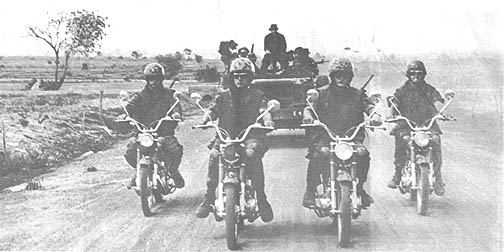 |
WILD ONES – Shades of Brando are recalled as Regulars ride through War Zone C. They are (l to r) Specialists 4 Dennis Verbrigghie, Rock City, Mich.; James Linder, Indianapolis; Specialist 5 Scott Anderson, Balsin Lake, Wisc.; and Specialist 4 James Tomusco, Lorain, Ohio. |
You Meet The Nicest People On the Trails of War Zone C
TAY NINH - Like Hell's Angeles, the Rat Patrol, and the Wild
Ones all rolled into one, the Reconnaissance Patrol of the 3d Battalion, 22d Infantry
Regulars prowls War Zone C with 175-cc motorcycles leading the rest of the patrol.
The four motorcycles were introduced into the patrol by the Regulars'
battalion commander, Lieutenant Colonel Robert Carmichael, who wanted a fast and efficient
way for his reconnaissance element to investigate the swarm of trails that twist through
the marshes and jungles of what used to be a reliable sanctuary for enemy troops.
"Knowing where the enemy is not is almost as good as knowing where he
is," Carmichael says. "This mobile unit can cover a great deal of territory in a
very short time, which enables us to gain information on the whereabouts of the enemy.
In addition to the motorcycles, the reconnaissance unit includes Rat Patrol
Type vehicles equipped with machine guns.
Patrol Leader First Lieutenant Stephen Campbell, Falls Church, Va., takes his
men out at dawn every morning, with the flack jacket, crash helmet-clad cyclists leading
the way. The unit has already uncovered several mortar and rocket sites used by enemy
forces.
Major Jospeh Hacia, the Regulars’ executive officer, is convinced of the
value of using the motorcycles. "At first I was very leery of the whole idea, but now
I am confident it was a good one," Hacia says. "Recon has provided us with
valuable information which normally we would not have."
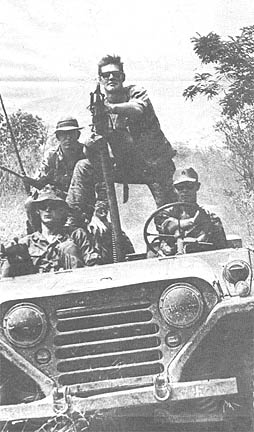 |
READY FOR ANYTHING – Specialist 4 Ron Jones mans the machine gun while PFC Jack Robey rides in rear ready to add fire or help feed the M-60. Driving is Staff Sergeant Floyd Huft, and Sergeant Brady Rosemeyer serves as the shotgun. |
| FIRING SITE – The night before the flick above was taken, North Vietnamese Viet Cong soldiers sent rockets toward a 25th Division camp from this site. Looking over the charge cans are Regulars Specialist 4 Cruez Lozano (left) of Wheller, Mich., and First Lieutenant Stephen Campbell of Falls Church, Va. | 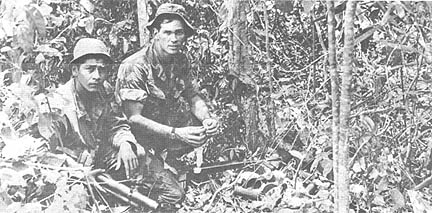 |
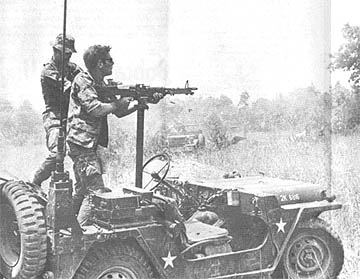 |
TEAMWORK – Sergeant Brady F. Rosemeyer of Bishop, Calif., feeds the M-60 as Specialist 4 Ron Jones of Bath, Maine, pours out the lead. |
| GETTING INTO those hard to reach places is the task of Dennis Verbrigghie and Scott Anderson (background.) | 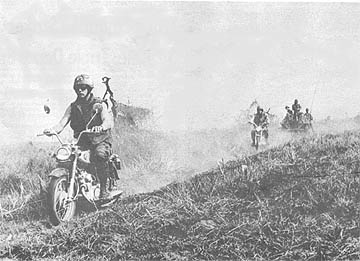 |
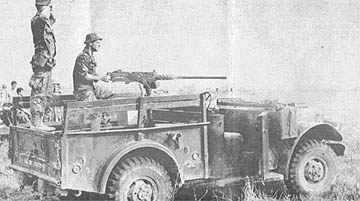 |
BRINGING SMOKE – Specialist 4 Paul DeShazer of Kansas City, Mo., tests his .50 caliber machine gun mounted on a ¾ ton. Looking on, but trying not to listen, is Specialist 4 Dennis Leaf of Champion, Mich. |
| Photo Feature By SP4 David DeMauro |
Page 6 TROPIC LIGHTNING NEWS April 28, 1969
Tropic Lightning Strikes in
Same Place 3d Time;
Triple Deuce Breaks Ambush
By SP4 D. J. CALDWELL
DAU TIENG - Tropic Lightning struck in the same place for the third time
in three months when 3d Brigade soldiers shattered an enemy attempt to ambush a convoy
near Dau Tieng recently.
History repeated itself as mechanized infantrymen of the 2d Battalion (Mech),
22d Infantry Triple Deuce, supported by artillery and helicopter gunships, decimated a
North Vietnamese Army reinforced battalion.
As on two previous occasions, the convoy was traveling on Route 239 near the
edge of a heavily wooded area 11 miles east-southeast of Tay Ninh City, when the North
Vietnamese opened up with small arms and RPG fire.
The enemy ambush was ill-starred from the beginning. Among the first to spot
the entrenched enemy was Colonel Louis J. Schelter, commander of the Tropic Lightning 3d
Brigade, who was flying overhead in his command and control helicopter.
Schelter and Lieutenant Colonel Vernon B. Lewis of Marshall, Tex, commander
of the 2d Battalion, 77th Artillery, began calling in artillery on the enemy positions.
Meanwhile Lieutenant Colonel Ralph M. Cline of Rockville, Md., Triple Deuce battalion
commander, committed his Alpha and Bravo companies to reinforce Charlie Company.
From his helicopter above the battleground, the brigade commander spotted an
enemy platoon running across an open field. As the aircraft, commanded by Warrant Officer
1 Gunther Siedler of Torrington, Wyo., blasted away, killing several enemy, the Mechanized
riflemen of Charlie Company Triple Deuce moved in to sweep the enemy force from the area.
As Bravo Company pulled up to join the fight, they ran into an enemy bunker
and spider hole position. Company Commander Captain Jack Johnston of Missoula, Mont.,
called in airstrikes to assist his men in routing the enemy from their positions.
Alpha Triple Deuce, commanded by Captain David Crocker, Old Mystic, Conn.,
encountered a group of NVA fleeing in the open north of the ambush site and stopped the
enemy in their tracks with a wall of machinegun fire.
Meanwhile, Cline and Lewis continued to call in a fusillade of accurate
artillery fire. Lewis called in deadly fire from Alpha Battery, 2d of the 77th
Artillery, Alpha Battery 1st Battalion, 27th Artillery, Charlie Battery, 2d Battalion, 32d
Artillery in Dau Tieng base camp and Bravo Battery, 3d Battalion, 13th Artillery in Fire
Support Base Wood.
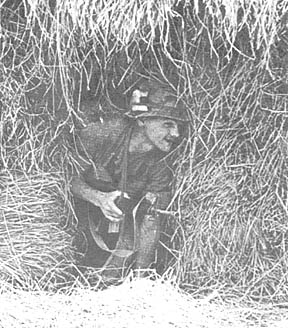 |
HIDDEN ENEMY BUNKERS can be found almost anywhere. Here Sergeant Robert Rakstanez of Chicago emerges from one built in a hay stack. The rice straw bunkers were discovered by 2d Battalion, 27th Infantry soldiers during an operation north of Saigon. (PHOTO BY SP4 B. WILLIAMS) |
All-Volunteer Company Takes on Job
As Guardian on Peak of Nui Ba Den
TAY NINH - Nui Ba Den, the legendary mountain that looms high above
Tay Ninh Province, in War Zone C, has a new security force atop her majestic perch. Tropic
Lightning soldiers of the 1st Brigade, 25th Infantry Division, were offered the chance to
volunteer for duty atop her mighty pedestal.
The new security company, an innovation introduced by division headquarters,
will man the bunker line that protects the valuable communication system atop the
"Black Virgin."
The old method of having an infantry company guarding the precious equipment
was not practical, headquarters decided. By having an all volunteer force, the infantry
can be used in their trained role - to search for the enemy, instead of acting as a
permanent bunker guard.
"The defense and security of the fabled mountain is the tightest in
Vietnam. My men are well trained and versed in their special role," said the security
company commander, Major Ronald L. Baker of Rapid City, South Dakota.
The Tropic Lightning soldiers do not hesitate to volunteer. Atop Nui Ba Den
the heat of the jungle is soon forgotten, the peace and tranquility that exists on the
mountain makes life pleasant. "I was surprised when I heard they wanted volunteers to
serve on the mountain. I didn't waste a minute getting my name on the list," said
Specialist 4 Edward Bischoff of Gallup, N.M.
"I've been up there before; the duty was just great. The climate is
cool, a soft breeze makes Vietnam bearable, and I can't wait to get back," stated
Specialist 4 Jesse Ware of Birmingham, Ala.
Both Bischoff and Ware served previously with Company A, 4th Battalion,
(Mechanized) 23rd Infantry.
| TOW AWAY ZONE - This giant Chinook offers a helping "sling" to a downed Cobra gunship that recently made a forced landing at the Dau Tieng base camp. The gunship was hit by sniper fire near the camp. (PHOTO BY SP4 JACK R. ANDERSON) | 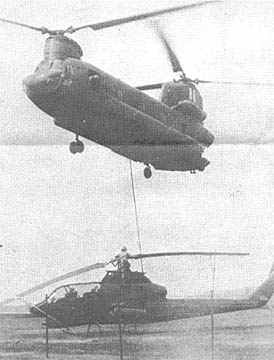 |
Tomahawks Pitch Teepees on
VC, NVA Happy Resupplying Grounds
TAY NINH - Patrol Base Mohawk was opened by mechanized infantrymen of
the 1st Brigade, 25th Infantry Division recently to close an enemy infiltration route to
Saigon. The Tropic Lightning troops, from the 4th Battalion (Mechanized), 23d Infantry, a
monumental task in establishing the base in thick jungle 55 miles northwest of Saigon.
In order to maintain security in the area, Mohawk had to be constructed in
only 24 hours. After the Lancer Brigade mechanized infantrymen penetrated the area,
workhorse CH-47 Chinook helicopters airlifted tons of wire, portable steel paving, and
thousands of sandbags to the site. Overcoming dust, heat, and fatigue, the lightning
troops accomplished their mission on time.
"All that hard work the first day paid off," remembered Private
First Class David Duree of Trigon, Ore. "Everybody was safe in his bunker the second
morning when the enemy decided to send in some mortar rounds."
Patrol Base Mohawk was purposely designed to be loaded with firepower.
"If Charlie ever tried anything here, he probably wouldn't even get past the
woodline," said Private First Class Reynold D Weinbrandt.
Page 7 TROPIC LIGHTNING NEWS April 28, 1969
C Company Total Soars to
154 for Year
Manchu Company Earns 60 Medals
TAY NINH - When 60 medals for valor were awarded to soldiers of the
4th Battalion, 9th Infantry Manchus' Charlie Company in a special ceremony March 31, it
brought to 154 the total of combat decorations the company has received since the start of
1969.
The Manchu battalion commander, Lieutenant Colonel Leo L. Wilson of Salina,
Kans., and Company Commander, Captain Ramon T. Pulliam of Chattanooga, Tenn., personally
pinned on 25 Bronze Stars with "V" devices for valor and 35 Army Commendation
Medals with "V" devices in a formal ceremony at Fire Support Base Sedgwick, 15
miles southeast of Tay Ninh.
Those 69 decorations, for a battle January 26, coupled with medals
distributed in two ceremonies earlier this year brought the company's 1969 tally to one
Distinguished Service Cross, 12 Silver Stars, 44 Bronze Stars with "V"s, and 97
Army Commendation Medals with "V"s.
The 94 other medals were earned Dec. 22, 1968, when the Manchus fought off a
North Vietnamese Army regiment's attack on Sedgwick, which was then Patrol Base Mole City.
In the January 26 action, C Company was flown by helicopter from Sedgwick to join the 3d
Squadron, 4th Cavalry, as a blocking force to bottle up a Viet Cong company which had
invaded Phuoc Luu, a small village 40 miles northwest of Saigon.
Using building materials shipped from Tay Ninh by helicopter, the Manchus dug
in for the night, working until midnight to construct bunkers with overhead cover. When
the VC unit attacked around 1 a.m. in an attempt to push through the U.S. barrier, the
bunkers proved invaluable. Only one Manchu was wounded, not seriously, as the Tropic
Lightning units battered the enemy force, recording an official total of 15 killed and
capturing a truckload of weapons and equipment.
In presenting the latest group of medals Wilson praised his C Company troops
as a "proven fighting unit."
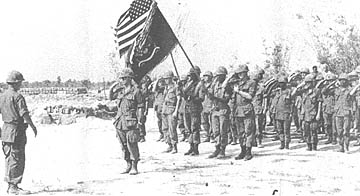 |
AWARD CEREMONY - Soldiers of C Company, 4th Battalion, 9th Infantry, salute their battalion commander, lieutenant Colonel Leo L. Wilson of Salina, Kans. (far left), at the end of a ceremony in which 60 of the company's men received medals for valor. (PHOTO BY SP4 RALPH NOVAK) |
Fire Brigade Slays 143 Enemy in NVA, VC Lair
CU CHI - One hundred
forty-three North Vietnamese soldiers died at the hands of 2d Brigade and supporting fires
five miles northeast of Trang Bang in two days of close, fierce fighting. On the first
morning of the two-day battle, Fire Brigade troopers made a helicopter assault into
enemy-infested area.
"We were just getting spread out when Charlie opened up," said
Private First Class Vernon Turner of Washington, D.C.
With gunships providing cover, the infantrymen regrouped to mass firepower on
the enemy. One unit commander, Captain Robert B. Powell, commented, "Charlie might
have had us but we blasted our way back with the aid of gunships."
Each time the Fire Brigade infantrymen advanced they were greeted by intense
small arms and .51 caliber fire.
As artillery and air strikes pounded the enemy's underground fortress,
regular and mechanized infantry forces were called in to reinforce their comrades and help
conduct a sweep of the area. As the task force began its sweep, it was again greeted by
automatic weapons and RPG fire from the entrenched enemy.
First Lieutenant Louis M. Geitka reported that it was "just like trench
warfare" as the Tropic Lightning soldiers moved forward to rout the persistent enemy.
"We fought from dike to dike and bunker to bunker," said Geitka .
As fire ceased and the sweep was concluded, 76 NVA bodies were discovered
along with three RPD machineguns, six AK-47s, five RPG launchers and a .51 caliber
machinegun.
The following day a combined armor-infantry task force moved out to
combat-assault the area. As soon as they got started they received mortar, small arms,
automatic and RPG fire from the north. Armored personnel carriers and tanks were called in
to aid the infantrymen once more. As the combined force fought against the North
Vietnamese troops on the ground, air strikes, gunships and 81mm mortars rained shrapnel on
the enemy.
Again as fire ceased the Fire Brigade soldiers began a sweep of the
battlefield and they received fire from a well hidden enemy force. After an hour duel the
last round flew overhead, and the Tropic Lightning infantrymen continued the sweep.
Tallied on the second day of fighting were 67 NVA bodies, one light
machinegun, 31 AR-47s, 15 RPG launchers, three .50 caliber machine guns, three carbines
and assorted munitions and documents.
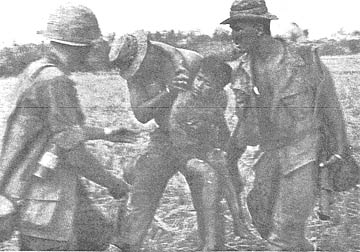 |
AID TO A CIVILIAN - Troopers from the 1st Battalion (Mechanized), 5th Infantry, aid a civilian injured by shrapnel. The boy was rushed to safety after he wandered into the deadly crossfire of a firefight. (PHOTO BY SGT JAN ANDERSON) |
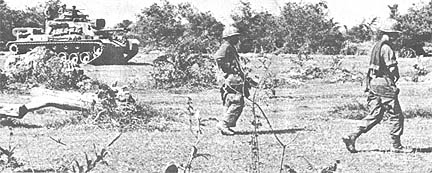 |
| STALKING elements from C Company 1st Battalion (Mechanized), 5th Infantry move out with the Dreadnaught Task Force during a sweep in the Filhol Plantation. The Fire Brigade operation is under the control of the 2d Battalion 34th Armor. (PHOTO BY SP5 DOUG ELLIOTT) |
Page 8 TROPIC LIGHTNING NEWS April 28, 1969
Bobcats Repel NVA Attack,
Slay 33
By SGT JAN F. ANDERSON
CU CHI - Fire Brigade soldiers from the 1st Battalion (Mechanized), 5th
Infantry Bobcats repulsed an unknown size enemy force April 10, forcing an NVA unit to
leave 33 dead comrades just outside a U.S. laager site only an hour after the communist
attack started.
There were no friendly casualties during the hour-long fight six miles
northeast of Trang Bang. Early detection of the attack was the Bobcat's key to success.
Sneaking close to the mech soldiers' position in an open rice paddy, five NVA had crawled
to within ten meters of the concertina wire ringing the men and their APCs. At 0320 hours,
Staff Sergeant Richard Hautekeete, Grinnell, Iowa, a platoon sergeant, sounded the alarm
after spotting the enemy quintet through his starlight scope.
Hautekeete quickly advised the commander of one of three tanks from the 2d
Battalion, 34th Armor on his flank of the danger to his front. A well-aimed round would
eliminate those five. The first round from the
tank's 90-mm cannon missed its mark, but number two killed all five, as the morning
sun was later to show. Caught off balance by the early detection, the enemy was forced to
begin his assault prematurely. While mortars and RPGs rained on the Bobcats, teams of
enemy troops moved into position for a human wave thrust against the wire.
Ground-mounted .50 caliber machine guns with their grazing fire inches above the
ground, mortar tubes arcing 81-mm high explosive rounds, and claymore mines, plus
helicopter gunships and an Air Force AC-47 Spooky gunship, all served to
effectively stifle the NVA charge.
First Lieutenant Jeffery McGrath, Mattituck, N.Y., executive officer of the Bobcat
unit said the enemy used a wedge-shaped formation to fix the brunt of their attack on one
point.
McGrath said the enemy repeatedly tried to blow apart the concertina wire with
bangalore torpedoes, each effort meeting with streams of automatic weapons fire.
"They came looking for a fight, and we gave them one," he said.
Specialist 4 Walter Brumwell, Baltimore, Md., gave the tanks a lot of credit.
"Fortunately for us they hit right at the point where the tank was," Brumwell
said. "The big gun was more than a match for them."
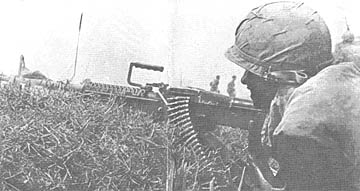 |
A BURST OF 100 - Specialist 4 Lee Spencer of Memphis, Tenn., a soldier with the 1st Battalion (Mechanized), 5th Infantry, rakes a VC-infested hedgerow with M-60 machinegun fire as 2d Brigade soldiers fight their way out of an enemy ambush. (PHOTO BY SGT JAN ANDERSON} |
WE’VE MADE CONTACT!
- (Below, right) Captain Luther Dewalt of Crosby, Tex., a company commander with the 4th
Battalion, 23rd Infantry, maneuvers his men while in the midst of a firefight,
13 miles east of Tay Ninh City. Two VC died in the action. (PHOTO BY SGT ROGER WELT)
Tomahawks Check Charlie’s Caches
RF Help Dig Up Bunker Complex
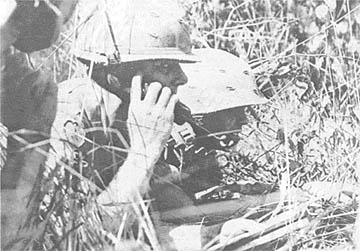 TAY NINH - Smashing through
dense jungle, 11 miles northeast of Tay Ninh City, South Vietnamese Regional Force
elements, working with Company B, 4th Battalion (Mechanized), 23d Infantry, found a
mammoth enemy weapons and munitions cache in a bunker complex.
TAY NINH - Smashing through
dense jungle, 11 miles northeast of Tay Ninh City, South Vietnamese Regional Force
elements, working with Company B, 4th Battalion (Mechanized), 23d Infantry, found a
mammoth enemy weapons and munitions cache in a bunker complex.
After finding the complex the Regional Forces advanced cautiously to check the area
for enemy soldiers. After a thorough search was completed and security put out, the R.F.s
searched the large bunkers. In the first bunker most of the bounty was found. Inside were
two RPD machine-guns, one AK-47, 14 SKS rifles, one Thompson sub-machinegun, one Chinese
light machinegun, one Chinese sub-machinegun, 30 bangalore torpedoes, 300 .51 caliber
rounds, 500 AK-47 rounds, 30 pounds of Chinese TNT, 60 RPG boosters, 75 cans of mortar
charges, 500 rounds of 7.62mm ammunition, and 2000 feet of commo wire.
Near the first bunker was another containing 1000 mixed 57mm and 75mm recoilless
rifle rounds, 650 mixed 60mm and 82mm mortar rounds, 25 large Chinese claymores, 75 B-40
rockets, 65 B-4l rockets, and 1500 electric fuses.
"We've been finding a lot of material that belongs to the enemy, but not
anything as big as this in the last few months. It was a fantastic find, " said
Captain Luther DeWalt of Okinawa, commanding officer of Bravo Company.
VC Troops Say Farewell
to Arms
TAY NINH - First Brigade troops of the 25th Infantry Division
uncovered two separate weapons caches while operating in the Crescent area 13 miles east
of Tay Ninh City.
Two companies of the 4th Battalion (Mechanized), 23d Infantry Tomahawks uncovered
the caches two miles apart. One company was working its way into a woodline when it was
met by small arms fire. As the U.S. troops pushed forward, the VC fell back, leaving one
dead comrade . The thick jungle thinned out revealing a 30-bunker storage area. The VC in
their hasty retreat left a large amount of military bounty.
The Tomahawks policed up 1500 rounds of .30 caliber ammo 3 SKS rifles, 5 bolt
action rifles one semi-automatic rifle, two Chicom machineguns, one medium machinegun, one
82mm mortar (base plate and tube), 10 bangalore torpedoes, and 27 82mm mortar rounds.
"We were on them so fast they didn't know what hit them. The VC tried to make
a stand; they sure didn't want to lose all that stuff," said Sergeant
Stanley Frew,
of Des Moines, Iowa, a squad leader.
The Tomahawks' Alpha Company was checking out a suspected VC bunker complex when it
came upon a smal1 base camp with enemy equipment strewn all over. "After setting up
security around the small base camp we started checking out each bunker. Somebody left in
a big hurry. We had a real Easter egg hunt," said Specialist 4 Richard Langer, of
Willowick, Ohio.
The other company found 3 SKS rifles, one bolt-action rifle, 25 RPG-2 rounds, 25
RPG boosters, 2750 rounds of assorted small arms ammo, 10 pounds of TNT, 80 automatic
rifle clips and 49 60mm mortar rounds.
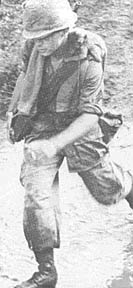 |
MONKEY ON MY BACK - Staff Sergeant Jeffrey Stefanovich of Gary, Ind., leaps across a small stream with his pet monkey. (PHOTO BY SP4 KARL KARLGAARD) |
RVN Government, 2d Bde Help Rebuild Village
after Terrorism
CU CHI - 2d Brigade, 25th Infantry Division troops rushed to the aid
of Xon Ben Moi village after terrorist fires left 70 families homeless recently. Xon Ben
Moi, a small Tay Ninh Province village, was set aflame about midnight for no apparent
reason by terrorists. 42 hootches were completely destroyed in three hours of systematic
burning. The villagers were allowed to escape. After the fires had been set, the VC
cleared out of the area.
Brigadier General Edwin F. Black, assistant Division Commander, heard of the
incident and knew 2d Brigade units were operating in the vicinity of the village. He
ordered that food and supplies be taken to the village immediately. Helping Hand and other
civic action groups gave the villagers 7,000 pounds of rice, 40 cases of staple foods, and
70 gallons of cooking oil the morning after the attack .
"We gave the food directly to the hamlet chief, and it was handed out by his
men," said 2d Brigade S-5 (Civic Action Section) Major Walter Burns. "We wanted
to let the people know that it was their government, not the US Army, that was helping
out. We just provided the food."
The Army is not through yet. More than 78,000 feet of lumber is being sent to the
hamlet. The first loads have already arrived and villagers are beginning to rebuild.
Thanks to
Paul Gargis, 3rd Bn., 22nd Inf. for sharing this issue,
Ron Leonard, 25th Aviation Bn., for locating and mailing it,
Kirk Ramsey, 2nd Bn., 14th Inf. for creating this page.
This page last modified 8-12-2004
©2004 25th Infantry Division Association. All rights reserved.